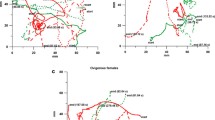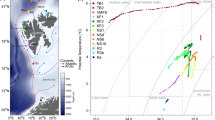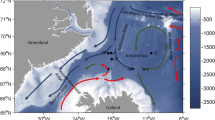Abstract
The entry of meiobenthic copepods from sediments or seagrass blades into the water column and reproductive characteristics of actively migrating fauna were investigated from 1981–1986 in a temperate intertidal Zostera capricorni seagrass bed in Pautahanui Inlet, New Zealand and in a subtidal Thalassia testudinum bed in Tampa Bay, Florida, USA. Emergence of copepods in New Zealand varied over a tidalcycle, while in Florida a distinct diel periodicity was displayed. Selected copepod species in New Zealand had similar numbers emerging from sediments and/or blades over a 6 h period as the common copepods actively migrating from sediments in Florida. Daily abundances of emerging copepods (24 h) in Tampa Bay, Florida, were substantially greater than those in New Zealand, where migration is linked to tidal cover. In Z. capricorni meadows in New Zealand, sex ratios of copepods in sediments and on blades were dominated by females; males dominated water-column samples. In T. testudinum meadows in Tampa Bay, sex ratios of males to females, although of a lowermagnitude than in Z. capricorni beds, were higher in trap than in sediment samples. Differences in sex ratios, the availability in emergence traps of females of appropriate stage for mating, and observations on clasping in live samples from traps suggest that swimming behavior in copepods may be partly linked to prenuptial courtship. Meiobenthic copepods may use the water column as an important habitat for reproductive behavior.
Similar content being viewed by others
Literature cited
Anger, K., Valentin, C. (1976). In situ studies on the diurnal activity pattern of Diastylis rathkei (Cumacea, Crustacea) and its importance for the “hyperbenthos”. Helgoländer wiss. Meeresunters. 28: 138–144
Alldredge, A. L., King, J. M. (1977). Distribution, abundance, and substrate preferences of demersal reef zooplankton at Lizard Island langoon, Great Barrier Reef. Mar. Biol. 41: 317–333
Bell, S. S., Sherman, K. S. (1980). Tidal resuspension as a mechanism for meiofauna dispersal. Mar. Ecol. Prog. Ser. 3: 245–249
Bell, S. S., Walters, K., Kern, J. C. (1984) Meiofauna from seagrass habitats: a review and prospectus for future research. Estuaries 7: 331–338
Brady, G. S. (1899). On the marine Copepoda of New Zealand. Trans. zool. Soc. Lond. 15: 31–54
Coull, B. C. Bell, S. S. (1979). Perspectives of marine meiofauna ecology. In: Livingston, R. J. (ed.) Ecological processes in coastal and marine systems. Plenum Press, New York, p. 189–216
Fenwick, G. (1984). Life history and population biology of the giant ostracod Leuroleberis zealandica (Baird, 1850) (Myodocopida). J. exp. mar. Biol. Ecol. 77: 255–289
Fincham, A. A. (1974). Periodic swimming behaviour of amphipods in Wellington Harbour. N. Z. Jl mar. Freshwat. Res. 8: 505–521
Fleeger, J. W., Chandler, G. T., Fitzhugh, G. R., Phillips, F. E. (1984). Effects of tidal currents on meiofauna densities in vegetated salt marsh sediments. Mar. Ecol. Prog. Ser. 19: 49–53
Gunnill, F. C. (1982). Macroalgae as habitat patch islands for Scutellidium lamellipes (Copepoda: Harpacticoida) and Ampithoe tea (Amphipoda: Gammaridae). Mar. Biol. 69: 103–116
Harding, G. C., Vass, W. P., Hargrave, B. T., Pearre, S., Jr. (1986). Diel vertical movements and feeding activity of zooplankton in St. Georges Bay, N.S., using tow nets and a newly developed passive trap. Can. J. Fish. aquat. Sciences 43: 952–967
Heck, K. L., Orth, R. J. (1980). Seagrass habitats: the roles of habitat complexity, competition and predation in structuring associated fish and motile macroinvertebrate assemblages. In: Kennedy, V.S. (ed.) Estuarine perspectives. Academic Press, New York, p. 449–464
Heip, C., Vincx, M., Vranken, G. (1985). The ecology of marine nematodes. Oceanogr. mar. biol. A. Rev. 23: 399–489
Hicks, G. R. F. (1985). Meiofauna associated with rocky shore algae. In: Moore, P. G., Seed, R. (eds.) The ecology of rocky coasts. Hodder & Stoughton, London, p. 36–56
Hicks, G. R. F. (1986). Distribution and behavior of meiofaunal copepods inside and outside seagrass beds. Mar. Ecol. Prog. Ser. 31: 159–170
Hicks, G. R. F., Coull, B. C. (1983). The ecology of marine meiobenthic harpacticoid copepods. Oceanogr. mar. Biol. A. Rev. 21: 67–175
Kern, J. C., Edwards, N. A., Bell, S. S. (1984). Precocious clasping of early copepodite stages: a common occurrence in Zausodes arenicolus Wilson (Copepoda: Harpacticoida). J. Crustacean Biol. (Lawrence, Kansas) 4: 261–265
Klie, W. (1927). Die Copepoda Harpacticoida von Helgoland. Wiss. Meeresunters. (Abt. Helgoland) 16: 3–19
Lang, K. (1948). Monographie der Harpacticiden. Hallan Ohlsson, Lund
Lewis, F. G. (1984). Distribution of macrobenthic crustaceans associated with Thalassia, Halodule and bare sand substrata. Mar. Ecol. Prog. Ser. 19: 101–113
Marcotte, B. M. (1984). Behaviourally defined ecological resources and speciation in Tisbe (Copepoda: Harpacticoida). J. Crustacean Biol. (Lawrence, Kansas) 4: 404–416
Palmer, M. A., Brandt, R. R. (1981). Tidal variation in sediment densities of marine benthic copepods. Mar. Ecol. Prog. Ser. 4: 207–212
Por, F. D. (1969). The Canuellidae (Copepoda, Harpacticoida) in the waters around the Sinai Peninsula and the problem of ‘Lessepsian’ migration of this family. Israel J. Zool. 18: 169–178
Robichaux, D. M., Cohen, A. C., Reaka, M. L., Allen, D. (1981). Experiments with zooplankton on coral reefs, or, will the real demersal plankton please come up? Pubbl. Staz. zool. Napoli (I: Mar. Ecol.) 2: 77–94
Roe, H. S. J. (1984). The diel migrations and distributions within a mesopelagic community in the North East Atlantic. 4. The copepods. Prog. Oceanogr. 13: 353–388
Scott, A. (1909). The Copepoda of the Siboga Expedition: Pt 1. Free-swimming, littoral and semi-parasitic Copepoda. Siboga Exped. Monogr. 29a: 1–323
Stoner, A. W. (1980). The role of seagrass biomass in the organization of benthic macrofaunal assemblages. Bull. mar. Sci. 24: 537–551
Summerson, H. C., Peterson, C. H. (1984). Role of predation in organizing benthic communities of a temperate-zone seagrass bed. Mar. Ecol. Prog. Ser. 15: 63–77
Walters, K. (In press). Diel vertical migration of sediment-associated meiofauna in subtropical sand and seagrass habitats. J. exp. mar. Biol. Ecol.
Walters, K., Bell, S. S. (1986). Diel patterns of active vertical migration in seagrass meiofauna. Mar. Ecol. Prog. Ser. 34: 95–103
Wieser, W. (1952). Investigations on the microfauna inhabiting seaweeds on rocky coasts. IV. Studies on the vertical distribution of the fauna inhabiting seaweeds below the Plymouth laboratory. J. mar. biol. Ass. U.K. 31: 145–174 (1952)
Willey, A. (1929). Report on the marine Copepoda collected during the Canadian Arctic Expedition. Rep. Can. arct. Exped. 7 (Part K): 3–46
Author information
Authors and Affiliations
Additional information
Communicated by J. M. Lawrence, Tampa
Rights and permissions
About this article
Cite this article
Bell, S.S., Hicks, G.R.F. & Walters, K. Active swimming in meiobenthic copepods of seagrass beds: geographic comparisons of abundances and reproductive characteristics. Marine Biology 98, 351–358 (1988). https://doi.org/10.1007/BF00391111
Accepted:
Issue Date:
DOI: https://doi.org/10.1007/BF00391111




